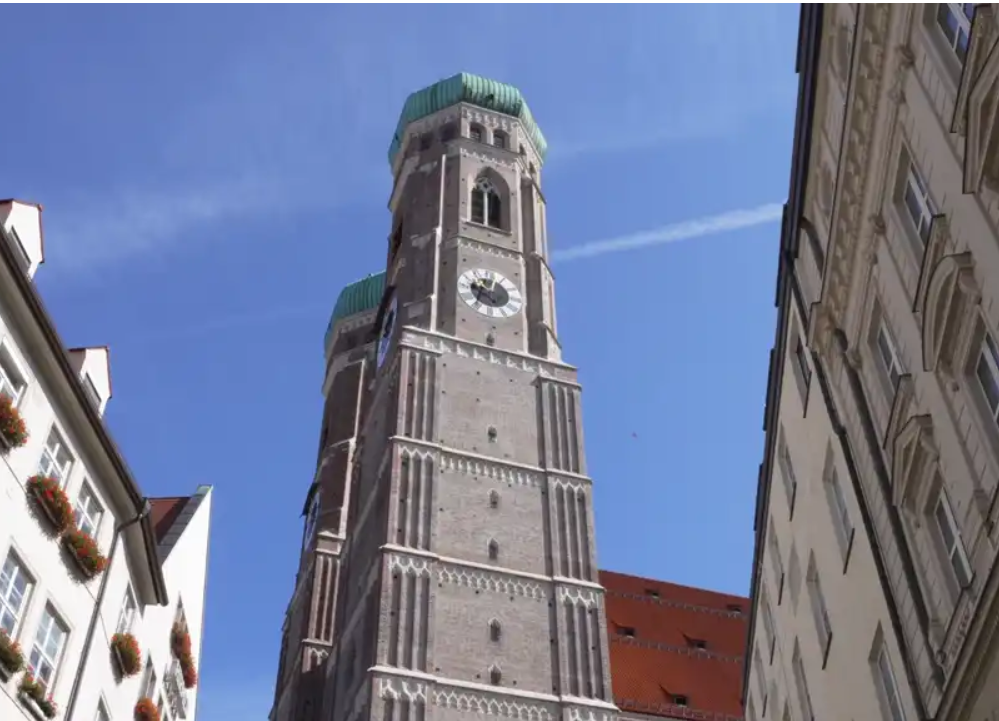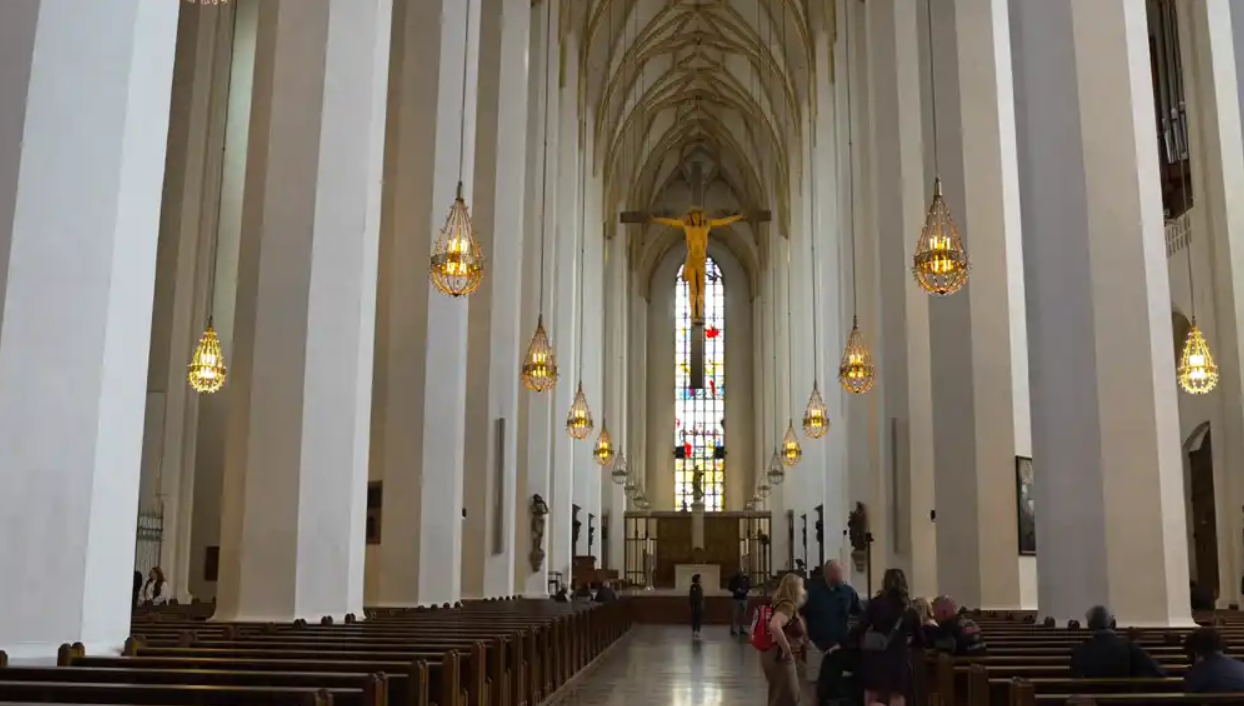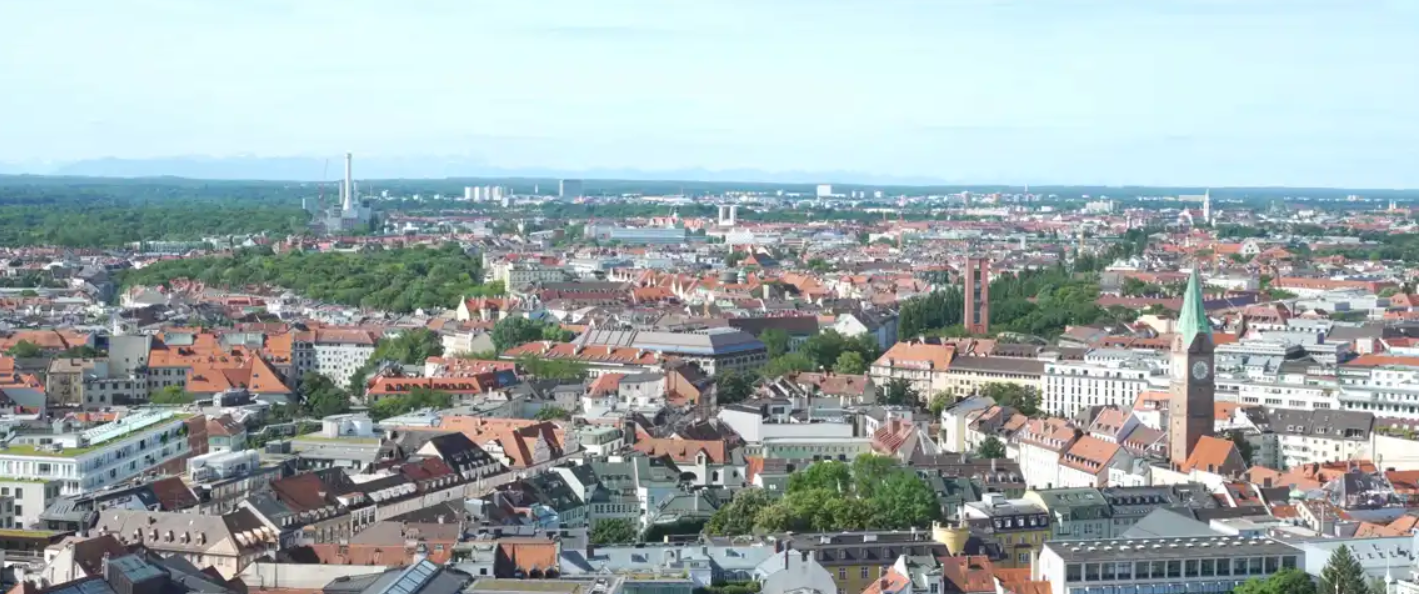Munich’s landmark with an impressive history
Address: Frauenkirche, Frauenplatz 1, 80331 Munich | Opened: 1494 | Height: 99 meters
The Frauenkirche is a special landmark of the city of Munich. Built in the Gothic style, the church is officially called the Cathedral and Parish Church of Our Lady. Its two twin towers, with their onion domes, are visible from afar and dominate the Munich skyline like no other building. The Munich master builder Jörg von Halsbach constructed the brick church in the 15th century. However, the Frauenkirche only received its typical “Welschen Hauben” (Welsh domes) 36 years after its completion. The imposing Frauenkirche impresses not only with its external appearance, but also with its architectural features and the legends surrounding the church.
Directions and location of this Munich landmark
Centrally located in Munich’s Old Town on Frauenplatz, the Frauenkirche (Church of Our Lady) with its impressive architecture and distinctive onion-domed towers is surrounded by other interesting city sights. The surrounding area is characterized by historic buildings, lively squares, and shopping streets. Along with the Residenz Palace and Marienplatz, the Cathedral of Our Lady is the heart of Munich’s cultural life and a tourist magnet. From Marienplatz, the Frauenkirche is just a few minutes’ walk away. To the northeast of the church is Residenzstraße, which runs past Odeonsplatz. The cathedral can also be reached directly via Liebfrauenstraße.
Opening Hours and Tours
The Frauenkirche in Munich can be viewed from the outside at any time of day. A visit in the evening hours is particularly impressive, when the cathedral is bathed in a special light by large spotlights. Anyone wishing to view the sacred building from the inside must adhere to the respective opening hours. Tours are not possible during services and concerts.
Frauenkirche Opening Hours
Monday to Saturday:
8:00 a.m. – 8:00 p.m.
Sunday:
8:30 a.m. – 8:00 p.m.
South Tower Frauenkirche Opening Hours
Monday to Saturday:
10:00 a.m. – 5:00 p.m.
Sunday:
11:30 a.m. – 5:00 p.m.

Admission Prices for the Frauenkirche
A tour of the Cathedral of Our Lady, with its magnificent altars and unique features, is free of charge. Those wishing to climb the south tower and enjoy views of the Alps and the city from its 16 windows will pay a reasonable admission fee.
Prices – Frauenkirche
Adults:
€7.50 per person
Children 7 years and older:
€5.50 per person
Children under 7 years:
Free
Guided Tours of the Frauenkirche
Guided tours of the Frauenkirche are offered daily at 11:30 a.m. by experts, except on public holidays. These tours provide participants with special insights into the church and highlight both small and important details. You can register for a tour in the cathedral shop or online at https://www.muenchen.travel/angebote/buchen/turmauffahrt-frauenkirche-muenchen/. The meeting point is in the north tower chapel.
FAQ – Frequently Asked Questions about the Frauenkirche in Munich
When was the Frauenkirche in Munich built?
A church stood on the edge of the former residence as early as 1240. It was built by the Wittelsbach dynasty. In the 15th century, the decision was made to build a larger and more prestigious church to accommodate the city’s population growth and expansion. The foundation stone of the new cathedral was laid in 1468.
Who built the Frauenkirche?
The master builder Jörg von Halspach from Munich was commissioned to build the cathedral. He constructed the imposing brick building in just 20 years. The towers with their typical “Welscher Kuppeln” (Welsh domes) were not completed until 36 years later.
How big is the Frauenkirche?
The Frauenkirche is a hall church with three naves and built in the late Gothic style. The nave is 109 meters long, 40 meters wide, and rises 37 meters high. The nave can accommodate up to 2,000 people.
How high are the church’s steeples?
The south tower is 98.45 meters high, and the north tower is 98.57 meters high.
Can the steeples be climbed?
The south tower of the cathedral is open to visitors. A spiral staircase with 89 steps leads up to an intermediate level. There, an elevator takes visitors up to the tower room. Once at the top, a stunning panoramic view of the entire city and the surrounding Alpine region opens up.
Why do the church steeples have names, and what are they called?
In the 1950s, a newspaper published an article asking Munich residents to name the church steeples of the Frauenkirche. Locals were invited to submit their suggestions to the newspaper. After reviewing the submissions, it was clear that the south tower would now be called Stasi (Anastasia) and the north tower Blasi (Blasius). These names can be traced back to the radio program “The White and Blue Barrel Organ,” which was particularly popular at the time and was broadcast by Bayerischer Rundfunk.
Frauenkirche Munich – Special Features and Interesting Facts
The Frauenkirche in Munich is a brick church with two towers and typical “Welscher Hauben” (Welsh domes) that rise almost 100 meters into the sky. The cathedral is a three-aisled hall church built in the late Gothic style.
The typical Gothic architectural style is clearly evident in the upward-stretching pillars in the interior of the Frauenkirche. A bright and open impression is created by the colorful leaded glass windows combined with white pillars and light ceiling vaults.
Compared to other Gothic churches, the Frauenkirche’s interior design is rather restrained. A closer look at the altar area reveals twelve interesting reliefs. Also depicting the life of the Virgin Mary and a statue of the Immaculate Conception. The paintings depict only Mary with the Christ Child and the pain-filled Jesus with his wounds.
The interior of the Frauenkirche also features impressive side chapels, paintings, altars, and epitaphs. The side chapels in particular are very diverse in design. An automaton clock dating back to the 16th century can also be found in the church.
A special feature of the Frauenkirche is the Wittelsbach Memorial and the Bishop’s Crypt. The magnificent cenotaph, richly decorated with bronze figures, stands out impressively from the church interior. The top of the memorial is adorned with a large imperial crown.
The Bishop’s Crypt is located beneath the Frauenkirche. Not only members of the noble Wittelsbach family are buried there. Archbishops of Munich and Freising have also found their final resting place there.
Anyone who carefully enters the entrance hall of the Frauenkirche will discover a footprint on the floor. According to legend, the footprint is said to be from the devil himself. The story goes that the devil made a bet with the architect for his soul. The story revolved around the fact that there are no windows in the cathedral.
Because the windows were cleverly hidden by the pillars, the devil couldn’t see them from that spot. His delight at the stupidity of the people was immense. He stamped his foot on the floor, leaving his footprint there.
As the devil continued further into the church, he saw the windows and realized that the builder had deceived him. His rage turned into a storm with which he wanted to destroy the church. According to legend, the devil is still trying to destroy the Frauenkirche today. A light wind can always be felt when approaching the Frauenkirche or entering the entrance hall.

Historical information and history of the Frauenkirche on Frauenplatz
The Frauenkirche stands in the heart of Munich, not far from Marienplatz. Since 1821, it has been Munich’s most famous landmark, the cardinal church of the Bishops of Munich and Freising. The patron saint of the church is the Virgin Mary. Officially, the Frauenkirche is called the Cathedral and City Parish Church “Zu Unserer Lieben Frau” (Our Lady).
A special feature of the Frauenkirche is the simple interior design, which gives the building a particularly imposing appearance. It is the smallest cathedral parish in all of Munich, with just over 300 Catholics.
Before the current Frauenkirche was built, there was already a small church, “Zu Unserer Lieben Frau” (Our Lady), in 1271. This church was commissioned by Bishop Conrad II. As the population in Munich continued to grow and the existing church became too small, a new church had to be built.
In the 15th century, the master builder Jörg von Halsbach was tasked with constructing a suitable new building with sufficient space for the congregation. After the foundation stone was laid in 1468, it took only 20 years for the church to be completed. Two commemorative plaques commemorating the day of the laying of the foundation stone can still be found on the south portal.
The new church building could now accommodate up to 20,000 people. However, the spires were still missing at that time. During the Landshut War of Succession, the domeless towers were used as cannon emplacements. In 1525, the towers were given the characteristic Italian domes. The design of the spires was modeled on the famous Dome of the Rock in Jerusalem.
The cathedral was severely damaged during air raids during World War II. Part of the building even collapsed. Most of the furnishings were stolen from the church by looters. This Munich landmark was rebuilt piecemeal after World War II. The last extensive renovations were carried out between 1989 and 1994.
The towers of the Frauenkirche, in particular, shape Munich’s cityscape in a very special way. Visitors can climb the 98.45-meter-high south tower and enjoy a unique view. During the ascent, the seven large bells in the south tower can be examined more closely and their size can be marveled at. The north tower houses three more bells. There is also a treadwheel there. It dates back to the Middle Ages and was used to transport building materials.
To ensure that the church towers remain a visible symbol of Munich, a referendum was held. The final decision was that no buildings higher than 100 meters could be built in the area of the Mittlerer Ring.

Sights and attractions in the immediate vicinity of the Frauenkirche
There are numerous sights and attractions to discover on a stroll in the immediate vicinity of the Frauenkirche. They are among the special gems and are usually not as clearly visible as the famous top sights.
In the center of Munich, in the Old Town, is Marienplatz. This square is dominated by the New Town Hall, built in the Gothic style. Directly adjacent to it is the Old Town Hall. The Marian Column stands majestically in the center of Marienplatz. From there, you can easily observe the historic carillon twice a day. The 43 bells have been ringing for around 100 years and commemorate the magnificent wedding of Duke William V.
Another special feature of Marienplatz is the Fish Fountain. From there, you have a stunning view of the Old Town Hall. The fountain is an impressive landmark from the Middle Ages.
Not far from the church is the Antiquarium in the Residenz Museum. The Antiquarium is one of the most magnificent and largest Renaissance halls north of the Alps. Admire magnificent and colorful murals and select exhibits in the treasury.
The Cabinet Garden on Alfons-Goppel-Straße is not only a place to linger. A stroll through the 19th-century gardens reveals small pools and modern sculptures.
Another imposing building near the Frauenkirche is the Feldherrnhalle (Field Marshals’ Hall). It is considered a historic monument, was built in the Italianate style in honor of the Bavarian army, and dates back to the 19th century. The building was also the site of the Hitler Putsch in 1923.
Cafés and Restaurants near the Frauenkirche
In the immediate vicinity of the Frauenkirche, you will find numerous restaurants, Bauhaus shops, and cafés where you can indulge in local specialties or national and international cuisine. On warm summer days, you can sit comfortably outside and enjoy the unique view of the Frauenkirche.
The Augustiner am Dom is a restaurant and beer garden belonging to the brewery of the same name, offering guests Bavarian beers and delicious classic Bavarian dishes. The restaurant has three floors and offers ample space. In nice weather, guests can sit comfortably outside and enjoy the special atmosphere of Frauenplatz.
Address: Augustiner am Dom, Frauenplatz 8, 80331 Munich
The Andrechser am Dom is located directly on Frauenplatz. Delicious food is served in a cozy atmosphere. The menu includes hearty dishes such as pork knuckle, white sausages with sweet mustard, freshly prepared mushroom dishes, and Kaiserschmarrn (sweet pancakes). Freshly tapped beers are also served. Even when it’s busy, you can still find a cozy spot inside or on the terrace.
Address: Andrechser am Dom, Frauenplatz 7, 80331 Munich
Ristaurante Guido al Duomo
If you want to enjoy fine Italian cuisine, Ristaurante Guido al Duomo is the place for you. The menu features numerous pasta dishes, delicious salads, and meat and fish dishes. Pizza is not available. The various dishes are freshly prepared and attractively served – because eating is a feast for the eyes. Due to the excellent location, a table reservation is highly recommended.
Address: Ristaurante Guido al Duomo, Frauenplatz 12, 80331 Munich
Kilian’s Irish Pub
If you’re in the mood for live music, tasty burgers, and fish & chips, while also choosing from a wide selection of beers, Kilian’s Irish Pub is the place for you. There’s a lovely outdoor area where you can sit outside on warm summer days and enjoy an ice-cold Guinness and delicious food. The staff keeps an eye on everything, so there are no long waits.
Address: Kilians Irish Pub, Frauenplatz 11, 80331 Munich
Leger am Dom
Located in the heart of Munich, right on Frauenplatz, is Leger am Dom. It’s a restaurant and daytime bar in one. Whether you’re looking for a quick snack, other tasty delicacies like Wiener Schnitzel from the kitchen, or a delicious cocktail – the menu has something for everyone. The ambiance is stylish and cozy, and when the sun is shining, you can also sit comfortably on the terrace.
Address: Leger am Dom, Kaufingerstraße 24, 80331 Munich
Chen’s Noodle Bar on Kaufingerstraße offers Asian and Chinese noodle dishes. The restaurant is located on the second basement level of Galeria Kaufhof and is a great place for a quick snack between meals. The noodles are made in-house and served with fresh ingredients. Vegetarian dishes are also available on the menu.
Address: Chen’s Nudelbar, Kaufingerstraße 1, 80331 Munich